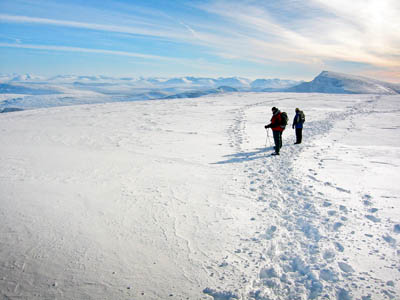Mountain experts are reminding Easter holidaymakers that Scotland’s hills are still in full winter condition.
With an early Easter this year and an expected influx of hillgoers, two mountaineering councils are advising walkers and climbers to be realistic in their ambitions.
The Mountaineering Council of Scotland and the British Mountaineering Council issued a joint statement today to urge anyone heading for the high ground to be aware the nation’s mountains are a serious winter challenge.
The councils said: “Climbers and hillwalkers need to be realistic about the seriousness of the Scottish mountains at this popular time of year, and of the need to match knowledge and experience to mountaineering objectives.”
There have been 12 deaths on Scotland’s mountains in 2013, many of which involved experienced and well equipped mountaineers.
The MCofS and BMC said those heading for the hills should assess avalanche risks. They said: “Sadly this winter has seen a significant death toll on Scotland’s mountains, many of them related to avalanches.
“Avalanche awareness should be a key component of planning a trip to the mountains over the Easter holiday period.”
MCofS president Brian Linington said: “There are always more visitors to Scottish mountains at Easter and Whitsun and we urge them to act upon this advice.
“Many are keen to get to grips with the mountains, but the pattern when I was part of the Skye Mountain Rescue Team was for a high number of incidents at Easter.
“This was due to a number of factors, including loose holds after winter ice had loosened everything up, together with very icy old snow patches in critical shaded spots. Both factors caused fatalities in the Cuillin at Easter.”
BMC deputy chief executive Nick Colton added: “The mountains of Scotland are glorious places to walk and climb.
“Go prepared; plan and heed the advice that is available. Remember conditions can change quickly and you may need to adjust those plans and expectations accordingly.
“Enjoy the challenges and spectacular scenery that Scottish hills have to offer but, most importantly, get back down safely.”
The two organisations issued a 10-point checklist for hillgoers.
- Check the mountain weather and avalanche forecasts
- Follow the MCofS on Twitter and Facebook, and check the Something for the Weekend #sftwe safety tips on Fridays and Saturdays. The messages warn of likely hazards over the coming weekend
- Be realistic about your ability to interpret and act upon weather and avalanche forecasts
- Be prepared to lower your expectations if weather, visibility and pace dictate
- Allow for the remoteness of many Scottish mountains
- Plan routes carefully and consider likely hazards like avalanche-prone slopes, river crossings and steep cliff faces
- Read the winter safety pages on the MCofS website and watch the Ice Axe Self Arrest video on the MCofS YouTube channel
- Day length increases at this time of year, but it is still easy to be caught out after dark. Everyone in a group should carry a head torch and spare set of batteries or a spare head torch with new batteries
- Be aware of everyone else in your group and don’t allow your group to get separated in poor visibility.
- Never be afraid to turn back. The most important objective of a day in the mountains is for there to be more days in the mountains in the future.

Jhimmy
15 March 201311. The clocks go forward 31.3.2013.
Believe you me, people can't take in this simple fact and the number it catches out will be huge.
12. If you're still a pudding after the Christmas festive and still UNFIT, think short walks!!!